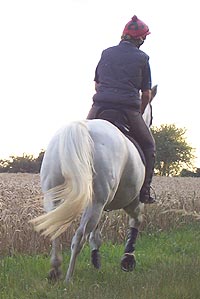
Sidebone - Bony deposits in a Horse or Pony's Foot

Sidebone is the name given to the calcification, ossification or bony deposits in the otherwise flexible lateral cartilage of the horse's foot.
Sidebone is a common condition in horses and most often occurs in the front feet. It does not usually cause lameness unless there are complications.
These supporting structures are found in all horses above and just forward of the heels of the horse's feet.
They are part of the anti-concussion mechanisms of the horse's foot - which also involve the frog and the navicular bone. The natural flexibility of the wall of the hoof also plays a part in anti-concussion.
Most horses get a degree of sidebone in the lateral cartilage of the foot as they get older without showing any signs of lameness.
Sidebone can be detected by feeling around the top of the coronary band - when there is loss of the normal flexibility of the heel over the affected cartilage.
The coronary band of the foot may bulge over the cartilage and the conformation of the hoof wall may become more upright.
However lameness can occur in horses with sidebone if some of the bony mass fractures - or if 2 separate ossifications develop and rub together.
This will present itself as an acute or sudden lameness. Your vet will be able to to X-ray the foot to confirm the diagnosis and assess the damage.
HOW TO TREAT LAMENESS CAUSED BY SIDEBONE
Fractures of sidebones often resolve to a much less painful situation if the horse or pony is rested for 6 to 12 months.
This allows a callous to form and stop the fragments of sidebone rubbing together - which is the cause of the pain.
Remedial farriery and skilled trimming of the feet to gradually encourage heel expansion is essential in the treatment of acute and longstanding sidebone.
The horse should be shod with a wide-webbed shoe with rolled toe. Nails should not be inserted behind the mid-quarters of the shoe.
To relieve the pain the horse may be given equine anti-inflammatory drugs such as Phenylbutazone or 'bute'.
CARE OF A HORSE WITH SIDEBONE
It is important to be careful about exercise. It is believed that too much road work or work on hard ground can con contribute to the early formation of sidebone in a horse - so it is a good idea to avoid this.
If your horse is in pain and goes lame give him as much time off as necessary.
Be alert to the weather too. The temperature, atmospheric pressure and humidity can affect bony processes - just as they do in humans.
HORSE CARE ADVICE AND EQUESTRIAN ARTICLES
White Line Disease | Arthritis Supplements for Horses | Equine Redworm | B vitamins | Herbs for Veterans | Hydrotherapy | Clivers | Feed Balancers | | Horse bedding advice | Equine Body Work | Ringworm | Colic | Feeding vegetables | Calming Herbs | Bot Eggs | Sticky Stifle | Sweet Iron Bit | Ragwort | Mare in Foal | Feeding Foals | Probiotics Worming | Magnesium | Pelham |